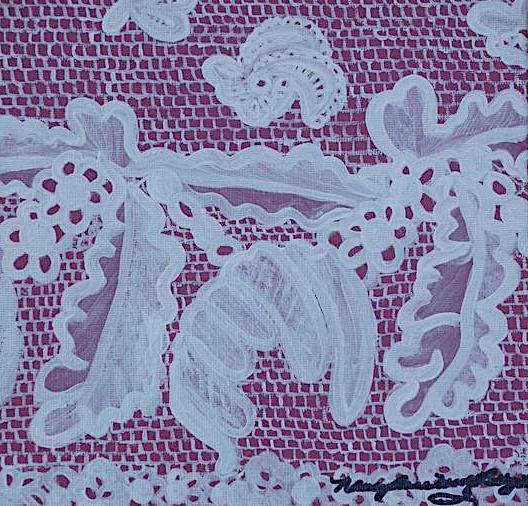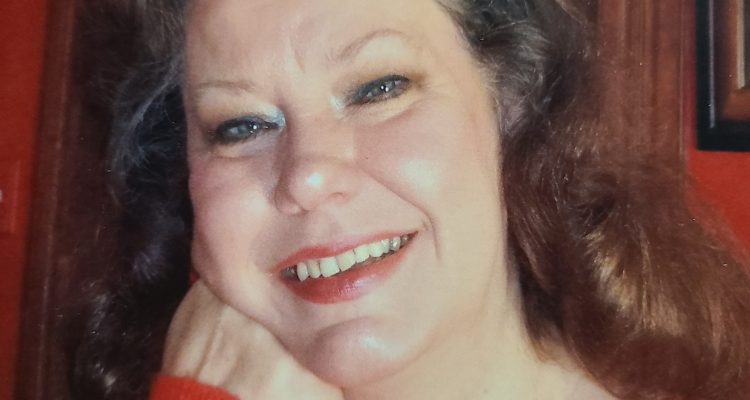“Lace has always been a love of mine …”
Paul Zimmerman in conversation with Nancy Anne Woolf-Pettyjohn
Paul Zimmerman: Your medium is as unique as your work. How did you get interested in lace?
Nancy Anne Woolf-Pettyjohn: Before law school I owned an antique shop and a vintage clothing museum from the late 1700’s to the 1920’s. Along with lecturing, refinishing furniture, appraising for Probate Court as well as patrons I restored and repaired old laces and linens. My Mom has been an avid collector of textiles for decades. After law school and working for lawyers and free-lancing as a Paralegal/Legal Assistant with 914 clock hours and studying all 10 fields of law I was told by lawyers including my boss they felt intimidated by me and I personally found law was much too easy for me. I found out I need to be mentally challenged. Lace has always been a love of mine and having a deep love for research of anything I wanted to combine the two sharing both my knowledge and art with the world.
Much to my surprise and delight, world curators have told me that I am the only known artist in the world to hand paint copies of actual textiles found in world museums with prior copyright to do so. To have an original idea out of some 3.7 billion people in the world is astounding. Other copyright permission paintings I have done have been both figurative and portraiture, a series on roses and a series on slavery in America which took over 2 years of both researching and getting copyright permissions. To think back that men were the first lace makers after spiders, Pilgrim men wore lace and roses even on their shoes, whole countries economies depended on lace, and that dogs were starved to death just to have laces sewn inside their bellies for smuggling; this is the kind of research that motivates my artwork.
PZ: What is the most challenging aspect of your lace paintings.
NAWP: To continue to hand paint with accuracy and detail.
PZ: What is your artistic process?
NAWP: I would have to say whatever that I am attracted to first of all. Then I research extensively finding out dates, facts and history, original artist and who holds the copyright, where is the original located, etc. The stories behind my figurative/ portraiture paintings for instance is what sets my artwork apart from others. If you were to research on Anne of Cleves and Mona Lisa you would find the stories both interesting and heart breaking. After my foundation of research is laid I then begin my art on a primed acid-free museum quality canvas using acrylic paint. I do not sketch in my design first I just literally paint it from start to finish using hand and eye technique in the style of the Old Masters. No computer generated software or lasers are ever used.
PZ: Do you have any particular goal in mind when you start a new piece?
NAWP: Hopefully to enlighten my audience with new found knowledge but also for them to appreciate the aesthetic value of the painting and all the hard work that it took to accomplish it. I hope that my research will be infectious and my work appreciated as they hand it down generation to generation.
PZ: How do you know when the work is finished?
NAWP: That is a funny question or me. My Mom is my biggest critic and then my husband has his own say of which I both appreciate. It seems that when all three of us gives a two thumbs up it is then finished!
PZ: Has your practice changed over time?
NAWP: No, I strive to continue to paint with both accuracy and detail of which I am internationally known for.
PZ: Which artists are you most influenced by?
NAWP: Bartolome’ Estaban Murillo. His paintings are fascinating to me each face is different from the next with no two alike. His expressions on their faces is what draws you in. Murillo could truly capture the emotions of his subjects such as his painting of the “Girl and her Duena” that I copied. The young girl is smitten and infatuated with the boy she sees on the street and her duena is softly giggling having her scarf around her face. One can truly hear the duena say, “Him? Oh my!” Both my parents. My Mom Lucy Woolf took as a small child along adults at the Kansas City Art Institute. Although I have never had any professional art lessons I had watched Mom all my life draw and paint and I just thought I would give it a try for myself. My Dad Homer Woolf who has passed away worked in chemistry and physics and had 5 patents for inventions. Both parents were written up in the Inventors Gazette. Both were always very creative and always coming up with new things. I continue in the ways of my folks by doing my own research, press releases, contracts, asking for copyright permissions from museums around the world, book publishers and authors and photographers even rose hybridizers to writing previous Pres. Obama. My husband Matthew Pettyjohn does all my photography and website. This is truly where I feel the most challenged.

PZ: How would you define art?
NAWP: Art is the creative self-expression of a person of any age or animal.
PZ: What are you working on now?
NAWP: I am trying to find better ways to make fur on small domestic animals look even more realistic. My feathers on my Chinese ring-necked pheasants and prairie chicken look so real. Another historical painting that I am doing is six dimensions a showing woman with roses in hand with a wall and doorway behind her exposing the terrace with a fountain and what lays behind the fountain. Really complex but beautiful.
PZ: How does the pandemic influence your work and sensibility?
NAWP: The pandemics have caused many places to either shut down temporarily or closed for good. Just like some years ago with the recession, many museums in the United States were laying off employees and not accepting any new art to be submitted. As an artist you have to take the current events in stride and look hopefully to the future that things will right itself once more. I feel so very sorry for anyone that lost their lives or that of a loved one; even for the covid survivors that still show symptoms. I know firsthand as in the 1970’s I had four fatal diseases that I contracted in the sterile O.R. studying to become a surgical missionary nurse at one time. Five doctors gave me no hope to survive but God alone healed me. I owned the antique shop while I was regaining my strength back. I personally know what they went through as the patient. My heart truly goes out to them. There is a light at the end of the tunnel. I am very grateful to God for all that He has blessed me with including my art talent, good health and the opportunities he allows me to share my art with the world. If you like my work I hope you will take the time to thank God from whom my talent comes from. My hope is that when the pandemics cease to be a problem for everyone around the world that people will have a renewed zest not only for the arts but for life and family as well.
